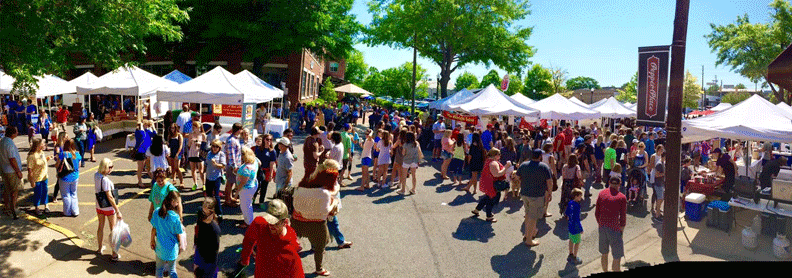 Cathy Sloss-Jones (left), founder of the Market at Pepper Place in Birmingham, Alabama (photo by D. Paul Jones III).
Cathy Sloss-Jones (left), founder of the Market at Pepper Place in Birmingham, Alabama (photo by D. Paul Jones III).These are not your father's farmers markets. If you visited a farmers market 20 years ago, you'd see local farmers selling recently harvested produce from the back of their pickups. Today's markets are a melting pot of craftsmen, artisans, farmers, and eateries.
More than produce stands, they're a gathering place where people go to socialize, listen to music, and share ideas. In some cases, the markets are drivers of economic growth and community revitalization. Such markets are exemplified by the Market at Pepper Place in Birmingham, Alabama, and the Nashville Farmers Market in downtown Nashville, Tennessee.
From seven tents to a bustling complex
The Market at Pepper Place is a 501(c)(3) nonprofit organization that started in 2000 with "seven farmers and a few tents in a parking lot," according to Cathy Sloss Jones. Jones is the president and chief executive officer of Sloss Real Estate Company and the founder of the Market at Pepper Place. She is also a former director of the Atlanta Fed's Birmingham Branch board of directors. She, along with others, recruited those first seven farmers and "then it grew larger than we ever could have imagined."
Today the market covers two city blocks, consists of about 125 farmers and vendors and draws 8,000 to 10,000 visitors every Saturday morning from April through December. Plans are currently in the works for the market to be open year round starting in 2017. The neighborhood around the market also continues to grow, with plans for new restaurants and 655 apartments units to be constructed in 2017.
For some proprietors, Pepper Place is a testing ground for their products. AL.com reported that the market serves as a "business incubator" for some vendors, fostering expansion and, in some cases, brick-and-mortar stores. Others discovered success nearly by accident when they took their products to Pepper Place—practically on a whim—and found unexpectedly large demand. Rod Palmer, a farmer from Turkeytown, Alabama, says farmers markets make up 85 percent of his business.
Before the Great Recession, Palmer was a housing contractor, farming only on a small scale. During the recession, when home construction slowed, he and a friend cast about for ideas for making a living. Since they already knew how to farm, they decided to make that their plan. They've been at Pepper Place for 15 years and they went from being a small vendor there to becoming, as Palmer put it, a "brand around Birmingham," adding that Pepper Place was a life changer for him.

Leigh Sloss-Corra, Pepper Place's executive director, tells us that during the 17 years the market has been operating, the number of shoppers has increased and the length of the market season has extended. She notes that farmers have begun growing a wider variety of crops and more of them, influencing the range and quality of food served in restaurants and sold in grocery stores and markets. "Visitors from New York, Boston and other culinary capitals often remark that there is more variety of produce and other foods than some of the best markets in the country," she said.
Deep roots in Music City
The Nashville Farmers Market—whose existence goes back to 1801—is also a 501(c)(3) business. The location has changed several times through the years, but it currently sits on the outskirts of downtown Nashville. In years past, the market served almost exclusively as a place where locals could buy produce from area farmers. Today, a good portion of the market is enclosed, housing 18 eateries, a pub, an international market, and a local-artisan store. Outside, the 106 open-air stalls can accommodate up to 140 farmers, artisans, and craft merchants.
The market is open 362 days a year and during peak season attracts between 3,000 and 4,000 visitors a day on weekends and close to 1,000 people each weekday. The area surrounding the market has grown robustly in recent years, boasting—among other real estate development—a new minor league baseball stadium and trendy restaurants. And like Pepper Place, the Nashville market also fosters business creation. The Grow Local Kitchen located inside the market serves as a business incubator for food entrepreneurs, continuing culinary education, and a promotional space for market merchants.
Even during the recession, farmers markets remained successful. Economist Ken Meter of Crossroads Resource Center notes that "as a business model, farmers markets are inherently flexible, which offers them protection from drastic economic changes. They can adjust price and adjust their product to meet consumers' needs quickly. Retailers can't do that." The growth and resilience of Pepper Place and the Nashville Farmers Market bear out Meter's statements.
According to U.S. Department of Agriculture data, the number of farmers markets in the United States rose from 3,706 in 2004 to 8,284 in 2014, an increase of 124 percent in 10 years. However, as reported by NPR, sales from farmers may be shifting to food hubs and farm-to-school programs. With the advent of the farm-to-table and local food movements, growing interest in clean eating (the term applied to eating minimally processed and refined food), and a desire to strengthen community connections, farmers markets will likely continue to evolve and grow.





